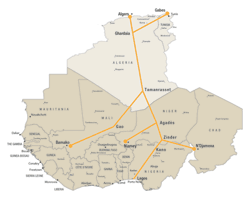Chad
Insecurity in the Sahel, the Arab Spring and trans-Saharan co-operation
Viewpoint by Laurent Bossard, 15 September 2011
|
While, within the context of chronic irredentism, the Sahel region is already weakened from instability that is fuelled by AQIM’s presence and by various illegal activities, North Africa is now also confronted with a wave of changes in the aftermath of the revolution in Tunisia. Its impact has swept across the Arab world, from the Maghreb (West) to the Machrek (East), and beyond. These two phenomena are closely interlinked and can not be analysed separately. While currently based in the Northern Sahel, AQIM has its roots in North Africa, and it sees the Arab Spring as an opportunity to regain control over former territories. Since the early 1980s, Colonel Gaddafi has incorporated thousands of Sahelian fighters into his “Islamic legion”. The Sahara and the Sahel are now faced with huge inflows of arms and ex-combatants, but also of innocent migrants fleeing Libya. Although the media often focuses on heavy weapons coming from Libya, it is important not to forget the large stocks of weapons that entered into West Africa at the time of the crisis in Côte d’Ivoire; these arms are now free to circulate wherever there is a perceived demand. Similarly, much less attention is currently paid to drug trafficking from South America to Europe via West Africa. However, this does not mean that it no longer exists. If fewer drugs have been intercepted, this is most probably a reflection of stronger and better-performing trafficking networks. “The region has been turned into a powder keg” stated Mohamed Bazoum, the Nigerien Minister of Foreign Affairs. Few would contest his assessment, and while we can fear for the worst, no one can truly imagine what the worst case scenario would actually be. For those who do try to make some predictions, it is important to remember that those events that shaped the past decade were entirely improbable. The Arab Spring is the most recent example. As we cannot make any reliable predictions for the future, we thus should acknowledge the transregional nature of what is happening and reflect on how to revive trans-Saharan co-operation. Admittedly, the four Sahelian countries (Algeria, Mauritania, Mali and Niger) plan to reinforce their co-operation in fighting terrorism. However, much more must be done. What about Chad, Libya, Morocco and Tunisia? What about the even greater ambition of North Africa finally reconnecting with its African hinterland; of West Africa rediscovering its geographically natural partner in the North and of the Sahara and its Sahelian fringe becoming once again a space for economic co-operation? Despite being often perceived as a threat, the Sahara is emerging as a strategic, resource-rich area (oil and minerals). Some are hoping to build a pipeline that would link Nigeria to the European market via Algeria, and others dream of constructing enormous solar energy parks. People living north of the Sahara are on average wealthier than those in Sub-Saharan Africa, but they have infinitely less water and less arable and pastoral land (Did not Gaddafi want to produce his rice stock in the fertile areas of the “Office du Niger” in Mali?). Morocco was the first to understand that there are plenty of economic opportunities for its entrepreneurs in West Africa and has thus concluded a trade agreement with UEMOA. Indeed, trade agreements between the two sides of the Sahara are crucial in order to: attract more North African capital to West Africa; generate more trade in agricultural goods, textiles and manufactured products; create trans-regional pipelines; and most importantly, construct more roads. This is by no means a new idea; we can only hope for a renewed interest by those countries concerned and their partners. |
 |
A trans-Saharan road could, for example, link Bamako, Niamey and Ndjaména to Alger and Gabes (Tunisia) via Tamanrasset (South Algeria); while proposed over thirty years ago, very little progress has been made in the implementation of this project. A network of roads across the Sahara would revitalize the area and thus trigger an upward spiral of positive change, bringing in electricity and telecommunications, generating trade, allowing for the creation of cities at their intersections and promoting the development of the mining and tourism sectors. |
In other words, it would create a favourable environment for economic activities and trade. In the short-term, it must of course be a priority to “re-conquer” and stabilize the area so that businesses and people can feel secure. In the long run, however, it is much more difficult and more expensive to militarily control an unsettled area than to develop a vibrant economic area.
Priority projects need to be conducted within a suitable institutional framework. The future of the Community of Sahel-Saharan States (CEN-SAD) is still, however, uncertain. Will it survive the fall of Colonel Gaddafi’s regime? Although CEN-SAD covers almost half of the continent, taking it far beyond purely trans-Saharan concerns, Algeria is not a member country. Developing an active economic co-operation between the countries of this desert region, however, is crucial, and an appropriate framework to facilitate dialogue and exchanges must be created. This dialogue could also be facilitated by the Arab Maghreb Union (which could be revitalised by the Arab Spring) and ECOWAS, in collaboration with UEMOA. CILSS should also contribute its expertise and invaluable inside knowledge of Sahelian issues in support of this ambition.
Now more than ever, the Sahara is revealing its true nature: a shared space whose risks and opportunities cannot be tackled without strong transregional co-operation . No policy, security advances or development can be sustained if it is pursued by individual states. North African and Sahelian challenges cannot and should not be dealt with separately.
Related Documents